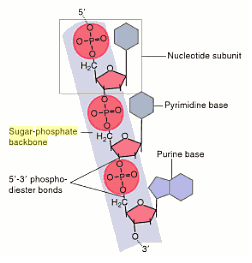Sugar phosphate backbone: Difference between revisions
Created page with "<u>'''Introduction'''</u> [[|]] The sugar phosphate backbone is an important stuctural component of DNA. It consists of 5-Carbon [[Deoxyribose sugar|deoxyribose sugar..." |
No edit summary |
||
| (3 intermediate revisions by 2 users not shown) | |||
| Line 1: | Line 1: | ||
The sugar phosphate backbone is an important stuctural component of [[DNA|DNA]]. It consists of 5-carbon [[Deoxyribose sugar|deoxyribose sugars and]] [[Phosphate group|phosphate groups]]. These sugars are linked together by a [[Phosphodiester bond|phosphodiester bond]], between [[Carbon|carbon]] 4 of their chain, and a CH<sub>2 </sub>group that is attached to a [[Phosphate|phosphate ion]]. They are extremely important in the function of [[DNA|DNA]]. | |||
The sugar phosphate backbone is an important stuctural component of [[DNA|DNA]]. It consists of 5- | |||
[[Image:Sugar Phosphate Backbone.png|left|Sugar Phosphate Backbone.png]] | [[Image:Sugar Phosphate Backbone.png|left|Sugar Phosphate Backbone.png]] | ||
<br> | |||
<br> | |||
<br> | <br> | ||
<br> | <br> | ||
<br> | <br> | ||
<br> | <br> | ||
<br> | <br> | ||
<br> | <br> | ||
<br> | <br> | ||
<br> | <br> | ||
<br> | <br> | ||
<br> | <br> | ||
< | '''Figure 1''' Diagram showing the sugar phosphate backbone of [[DNA|DNA,]] and the [[Base|nitrogenous bases attached]] to it, forming a [[Nucleotide|nucleotide ]]<ref>Krebs J.E. Goldstein E.S. Kilpatrick S.T 2011 Lewin's Genes X, 10th Edition, Jones and Bartlett Publishers: London</ref> | ||
=== Structure of DNA === | |||
-- | [[DNA|DNA]] is wound into an [[Double helix|right-handed double helix]]. The strands are anti-parellel i.e. one runs 3' to 5', the other run 5' to 3'. This is done by the sugar phosphate backbone twisting around itself in a coil. The purpose of this twisting is to protect the [[Base|bases]] inside it, and prevent them from being damaged by the environment. DNA is very stable due to rungs of “ladder” is hydrophobic and phosphate sugar backbone of DNA is negatively charged. These features make DNA can repel water and would not hydrolysed and breakdown by the aqueous environment. One turn of this [[Double helix|helix]] is 34nm long, the diameter of it is 2nm, and there are ten [[Base|bases]] attached per turn at 0.34nm. | ||
=== Differences in RNA and DNA === | |||
[[MRNA|RNA]] and [[DNA|DNA]] are both examples of [[Phosphodiester bond|phosphodiesters]] and have a very similar structure. However, their sugar phosphate backbone differs slightly. In [[DNA|DNA]], the sugar involved is [[Deoxyribose|deoxyribose]]. On on the other hand, the sugar in the backbone of [[MRNA|RNA]] is called [[Ribose|ribose]]. These two sugars only differ by one -OH group being changed to an -H, but provides different capabilities for each molecule<ref>Berg J.M. Tymoczko J.L. Stryer L. 2012 Biochemistry (pages 114-115), 7th Edition, WH Freeman and Company: New York</ref>. | [[MRNA|RNA]] and [[DNA|DNA]] are both examples of [[Phosphodiester bond|phosphodiesters]] and have a very similar structure. However, their sugar phosphate backbone differs slightly. In [[DNA|DNA]], the sugar involved is [[Deoxyribose|deoxyribose]]. On on the other hand, the sugar in the backbone of [[MRNA|RNA]] is called [[Ribose|ribose]]. These two sugars only differ by one -OH group being changed to an -H, but provides different capabilities for each molecule<ref>Berg J.M. Tymoczko J.L. Stryer L. 2012 Biochemistry (pages 114-115), 7th Edition, WH Freeman and Company: New York</ref>. | ||
=== References === | |||
<references /> | <references /> | ||
Latest revision as of 16:58, 4 December 2016
The sugar phosphate backbone is an important stuctural component of DNA. It consists of 5-carbon deoxyribose sugars and phosphate groups. These sugars are linked together by a phosphodiester bond, between carbon 4 of their chain, and a CH2 group that is attached to a phosphate ion. They are extremely important in the function of DNA.

Figure 1 Diagram showing the sugar phosphate backbone of DNA, and the nitrogenous bases attached to it, forming a nucleotide [1]
Structure of DNA
DNA is wound into an right-handed double helix. The strands are anti-parellel i.e. one runs 3' to 5', the other run 5' to 3'. This is done by the sugar phosphate backbone twisting around itself in a coil. The purpose of this twisting is to protect the bases inside it, and prevent them from being damaged by the environment. DNA is very stable due to rungs of “ladder” is hydrophobic and phosphate sugar backbone of DNA is negatively charged. These features make DNA can repel water and would not hydrolysed and breakdown by the aqueous environment. One turn of this helix is 34nm long, the diameter of it is 2nm, and there are ten bases attached per turn at 0.34nm.
Differences in RNA and DNA
RNA and DNA are both examples of phosphodiesters and have a very similar structure. However, their sugar phosphate backbone differs slightly. In DNA, the sugar involved is deoxyribose. On on the other hand, the sugar in the backbone of RNA is called ribose. These two sugars only differ by one -OH group being changed to an -H, but provides different capabilities for each molecule[2].